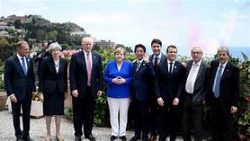Québec City, QC – US President Donald Trump is coming to Canada later this week….let the banners fly and the trumpets blare…or more accurately let the fur fly and tempers flare!
So when the leaders of the G-7 countries meet in the Québec capital, it will be Trump on the hot seat and his recent trade actions with the European Union, Canada and Mexico are responsible for lighting the fire.
Unhappy with the status of NAFTA negotiations, Trump levied a 25 per cent tariff on imported Canadian, Mexican and European steel and 10 per cent on aluminum effective June 1st. According to the Trump administration, the tariffs are being levied to protect American national security interests. Prime Minister Justin Trudeau called the tariffs an affront to the security partnership between Canada and the United States. “It is inconceivable that trade with Canada could pose a threat to the United States,” he said. The decision to target Europe and America’s next door neighbours comes as trade tensions with China are deteriorating after Trump tore up a truce agreed to earlier this month.
Retaliation was quick by Canada, Mexico and the European Union with punitive measures targeting American products worth billions of dollars. Chrystia Freeland, Canada’s Minister of Foreign Affairs outlined Canada’s response last Thursday. “Canada will place tariffs on American goods, including steel and aluminum, some will be taxed 10 per cent, others will be taxed 25 per cent,” she said. Up to about $12.8 billion will be subject to the tariffs, which was the total value of last year’s Canadian steel and aluminum exports to the U.S.
Mexico imposed tariffs on about $3 billion (U.S.) worth of U.S. pork, whiskey, cheese and other goods. The European Union’s retaliatory measures, consisting of 25 per cent tariffs on motorcycles, denim, cigarettes, cranberry juice and peanut butter, would take effect as early as June 20th. Canada’s measures will be implemented July 1st.
The biggest losers from this U.S. – Canada trade war are the industrial states around the Great Lakes. Ohio, which sent $1.75 billion worth of goods to Canada in 2017, would be the hardest hit, followed by Michigan with $1.17 billion, New York with $1.16 billion, and Pennsylvania with $1.14 billion and Illinois with $1.02 billion.
So with all of these tariffs and counter tariffs going back and forth, is there anything the G7 leaders can talk about let alone agree upon? “The facts are pretty clear to everyone, a lot of our members on both sides of the border are going to be hurt by these measures,” said a disappointed IAM Canadian GVP Stan Pickthall. “Let’s hope sanity prevails and they can all arrive at some common ground in the end.”
-30-



